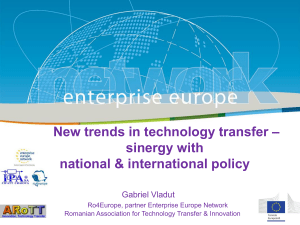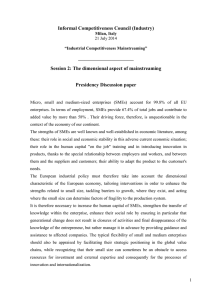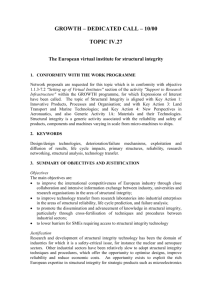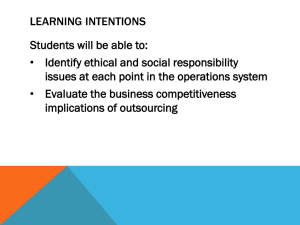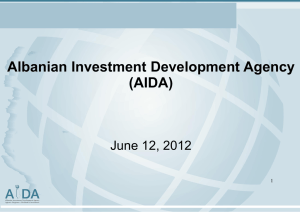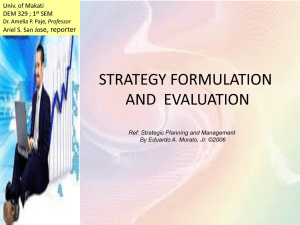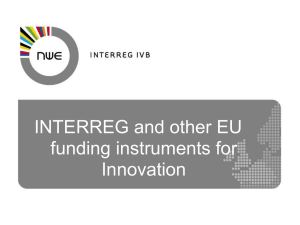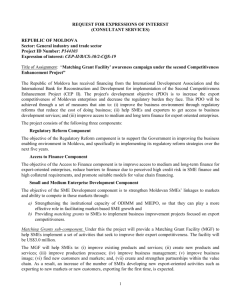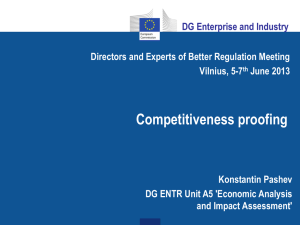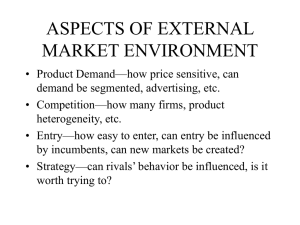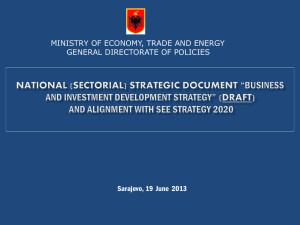Projects 5/8: Strategic networks in the EU 27, ECORYS Brussels
advertisement
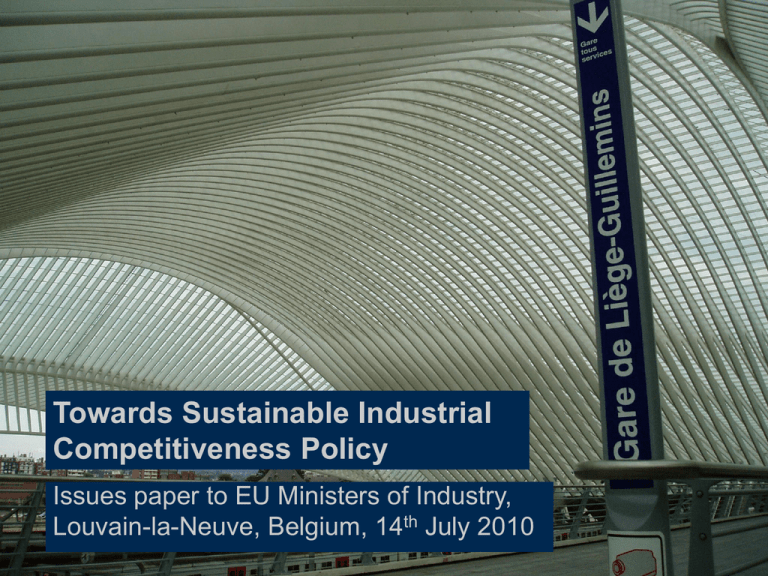
Towards Sustainable Industrial Competitiveness Policy Issues paper to EU Ministers of Industry, Louvain-la-Neuve, Belgium, 14th July 2010 Background and purpose • The economic crisis should serve as a “wake-up call” for the EU - emphasising the need to come to grips with transformation • The Europe 2020 Strategy calls for the development of policies “to deliver smart, sustainable and inclusive growth” • The Competitiveness Council of March 2010 calls for a renewed industrial policy with a focus on sustainability, ecoefficiency, and innovation • The purpose of the issues papers: a broader reflection on the longer term implications of combining ‘sustainable development’ with ‘industrial competitiveness policy’ • Two cases: “SMEs, Growth and Innovation” and “Transfomation and the Resource-intensive Industries” General industry challenges • Value chains are increasingly complex and intertwined, within and across sectors • Industrial sectors can no longer be treated as homogenous, independent and national • Competitiveness builds upon existing assets – often more than jumping upon current technology ‘bandwagons’ • Emerging economies are increasingly positioning themselves in ‘high-tech’ sectors – the crisis has reinforced this trend • Unforeseen and sudden shifts in relative competitiveness are likely to increase in the future • Addressing energy and environmental challenges Sustainable Industrial Competitiveness Framework Implications for future industrial policy • Industrial policy may require a finer level of resolution than simply sectors • Generic policies should be combined with targeted policies (instead of horizontal versus sectoral policy mixes) • Anticipation of potential future developments is crucial for policy development • Stability, predictability and transparency of regulatory conditions are important for promoting competitiveness • Multi-dimensional policy governance frameworks should be developed and/or strengthened Sustainable Industrial Competitiveness Policy Framework Case 1: SMEs, Innovation and Growth General industry challenges for Innovative SMEs • Significance of highly innovative, high-growth SMEs for economic growth and industrial transformation • More young, innovative companies are needed to support the transformation to a greener, sustainable economy • Specific constrains on SME innovation: limited access to finance, appropriation of benefits from R&D, lack of absorption capacity (limiting diffusion of innovation) • Particular constraints on the growth of innovative SMEs: market fragmentation (lack of standards), market access barriers and access to (venture) capital Implications for future industrial policy • Small Business Act as a good example; a need for a specific ‘SBA for Innovation’ as part of a reviewed Act • Generic policies towards SMEs to be combined with targeted policies towards sub-sets of SMEs • Innovative clusters as an element of response – and reinforce their international and EU dimension (vertical coordination) • Address the limited access to finance • Strengthen demand-driven policies and better connect them so supply-driven policy tools • Multi-level governance as part of a new framework for policies towards SMEs (Strategic Innovation partnerships) Case 2: Transformation and the Resource-intensive Industries General industry challenges for the Resource-intensive industries • EU’s resource-intensive industries have implemented extensive restructuring measures • The economic crisis resulted in a strong decrease in demand. Future growth is expected to be driven by demand in emerging markets • Exposure to global competition is increasing: both import growth and reduced share of EU in global outputs • Commodity and energy prices fluctuate strongly: a rollercoaster • Global energy prices: no level playing field due to energy price subsidies in non-OECD countries ($ 557 billion in 2008) • Continued access to both energy and natural resources no longer secured – strategic stockpiling as an increasingly common practice Impacts of these challenges on the EU’s Resource-intensive industries • Higher prices will reduce competitiveness both in domestic and in export markets • Serious implications for other downstream EU industries in the value chain – more reliant on imported inputs and reducing intra-industry synergies and innovation • Adverse global environmental impacts from shifts to non-EU based production expected • Industry has a key role to play: three transformation strategies: - Process innovation - Moving to ‘up-market’ segments - Increase presence in growth markets Implications for future industrial policy: provide a long-term framework: 1) Short-term mitigation policies to respond to temporary shocks (e.g. short term work arrangements) 2) Market-regulation measures (EU-level) – including energy efficiency, environmental impact and trade – focus on demand-side 3) Coordination measures and action plans (also at global level) 4) Capacity building and investment measures – including education and training (national and regional levels) Finally: a Sustainable Industrial Competitiveness Policy needs to: 1. Be based on real challenges and issues for industry, anticipate and support transformation towards a green, global economy 2. Provide a long-term framework that allows and supports such transformation and the necessary investment 3. Be holistic and integrated and apply various policy strands, both generic and specific 4. Reinforce demand-side policies, especially when supporting the market uptake of innovations 5. Provide Coherence, coordination and integration – towards multilevel governance 6. Importance of expanding impact assessments at all levels Thank you for your attention Jan Maarten de Vet <janmaarten.devet@ecorys.com Paul Baker <baker.paul.s@gmail.com> Vincent Duchêne <vincent.duchene@ideaconsult.be
